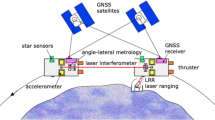Abstract
Since its launch in 2002, the Gravity Recovery and Climate Experiment (GRACE) mission has been providing measurements of the time-varying Earth gravity field. The GRACE mission architecture includes two satellites in near-circular, near-polar orbits separated in the along-track direction by approximately 220 km (e.g. collinear). A microwave ranging instrument measures changes in the distance between the spacecraft, while accelerometers on each spacecraft are used to measure changes in distance due to non-gravitational forces. The fact that the satellites are in near-polar orbits coupled with the fact that the inter-satellite range measurements are directed in the along-track direction, contributes to longitudinal striping in the estimated gravity fields. This paper examines four candidate mission architectures for a future gravity recovery satellite mission to assess their potential in measuring the gravity field more accurately than GRACE. All satellites were assumed to have an improved measurement system, with an inter-satellite laser ranging instrument and a drag-free system for removal of non-gravitational accelerations. Four formations were studied: a two-satellite collinear pair similar to GRACE; a four-satellite architecture with two collinear pairs; a two-satellite cartwheel formation; and a four-satellite cartwheel formation. A cartwheel formation consists of satellites performing in-plane, relative elliptical motion about their geometric center, so that inter-satellite measurements are, at times, directed radially (e.g. parallel to the direction towards the center of the Earth) rather than along-track. Radial measurements, unlike along-track measurements, have equal sensitivity to mass distribution in all directions along the Earth’s surface and can lead to higher spatial resolution in the derived gravity field. The ability of each architecture to recover the gravity field was evaluated using numerical simulations performed with JPL’s GIPSY-OASIS software package. Thirty days of data were used to estimate gravity fields complete to degree and order 60. Evaluations were done for 250 and 400 km nominal orbit altitudes. The sensitivity of the recovered gravity field to under-sampled effects was assessed using simulated errors in atmospheric/ocean dealiasing (AOD) models. Results showed the gravity field errors associated with the four-satellite cartwheel formation were approximately one order of magnitude lower than the collinear satellite pair when only measurement system errors were included. When short-period AOD model errors were introduced, the gravity field errors for each formation were approximately the same. The cartwheel formations eliminated most of the longitudinal striping seen in the gravity field errors. A covariance analysis showed the error spectrum of the cartwheel formations to be lower and more isotropic than that of the collinear formations.
Similar content being viewed by others
References
Aguirre-Martinez M and Sneeuw N (2002). Needs and tools for future gravity measuring missions. Space Sci Rev 108: 409–416
Bender PL, Hall JL, Ye J and Klipstein WM (2003). Satellite–satellite laser links for future gravity missions. Space Sci Rev 108: 377–384
Brouwer D (1959). Solution of the problem of artificial satellite theory without drag. Astronaut J 64: 378–397
Dolesi R, Bortoluzzi D, Bosetti P, Carbone L, Cavalleri A, Cristofolini I, DaLio M, Fontana G, Fontanari V, Foulon B, Hoyle CD, Hueller M, Nappo F, Sarra P, Shaul DNA, Sumner T, Weber WJ and Vitale S (2003). Gravitational sensor for LISA and its technology demonstration mission. Classical Quantum Gravity 20(10): S99–S108
Dunn C, Kim J, Bar-Sever Y, Desai S, Haines B, Kuang D, Franklin G, Harris I, Kruizinga G, Meehan T, Nandi S, Nguyen D, Rogstad T, Thomas JB, Tien J, Romans L, Watkins M, Wu S, Bettadpur S and Bertiger W (2003). Instrument of GRACE: GPS augments gravity measurements. GPS World 14(2): 16–28
Flechtner F (2007) AOD1b product description document for product releases 01 to 04. GRACE 327-750 (GR-GFZ-AOD-0001), Rev 3.0, GeoForschungszentrum Potsdam, Department 1: Geodesy and Remote Sensing
Marchetti PJ (2006) Electric propulsion and controller design for drag-free spacecraft operation in low Earth orbit. Master’s thesis, Worcester Polytechnic Institute
Massonnet D (1998) Roue interfŕométrique. French patent no 339920D17306RS
Mueller G, Thorpe I, Mcnamara P, Camp J (2005) Laser frequency stabilization for LISA. NASA/TM-2005-212794, NASA Goddard Space Flight Center
Pierce R, Leitch J, Stephens M, Bender P, Nerem R (2008) Inter-satellite range monitoring using optical interferometry. Appl Opt (in press)
Rummel R, Balmino G, Johannessen J, Visser P and Woodworth P (2002). Dedicated gravity field missions—principles and aims. J Geodyn 33: 3–20
Schaub H and Alfriend K (2001). J2 invariant relative orbits for spacecraft formations. Celestial Mech Dyn Astron 79: 77–95
Sharifi M, Sneeuw N, Keller W (2007) Gravity recovery capability of four generic satellite formations. In: Kilicoglu A, Forsberg R (eds) Gravity field of the Earth. General Command of Mapping, ISSN 1300-5790, Special Issue 18, pp 211–216
Sneeuw N, Flury J and Rummel R (2005). Science requirements on future missions and simulated mission scenarios. Earth Moon Planets 94: 113–142
Sneeuw N, Sharifi M, Keller W (2008) Gravity recovery from formation flight missions. In: Peiliang X, Jingnan L, Athanasios D (eds) VI Hotine-Marussi Symposium on theoretical and computational geodesy, vol 132. Springer, Heidelberg
Tapley BD, Bettadpur S, Watkins M, Reigber C (2004a) The gravity recovery and climate experiment: mission overview and early results. Geophys Res Lett 31:L09607. doi:10.1029/2004GL019,920
Tapley BD, Schutz BE and Born GH (2004b). Statistical orbit determination. Elsevier, San Diego
Thompson P (2007) Private communication
Touboul P, Willemenot E, Foulon B and Josselin V (1999). Accelerometers for CHAMP, GRACE, and GOCE space missions: synergy and evolution. Bollettino di Geofisica Teorica ed Applicata 40: 321–327
Webb F, Zumberge J (1995) An introduction to GIPSY/OASIS-II precision software for the analysis of data from the Global Positioning System. JPL Document D-11088, Jet Propulsion Laboratory
Young BC, Cruz FC, Itano WM and Bergquist JC (1999). Visible lasers with subhertz linewidths. Phys Rev Lett 82(19): 3799–3802
Author information
Authors and Affiliations
Corresponding author
Rights and permissions
About this article
Cite this article
Wiese, D.N., Folkner, W.M. & Nerem, R.S. Alternative mission architectures for a gravity recovery satellite mission. J Geod 83, 569–581 (2009). https://doi.org/10.1007/s00190-008-0274-1
Received:
Accepted:
Published:
Issue Date:
DOI: https://doi.org/10.1007/s00190-008-0274-1




